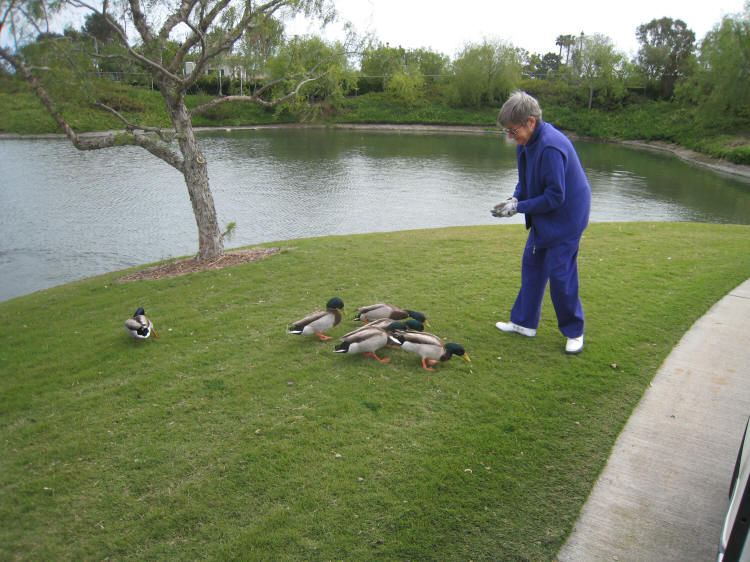The Animals Of Old Ranch Country Club
Old Ranch is full of critter's that roam the greens and provide entertainment to the players. They enjoy the great water hazards and the deep lush foliage around the course. They come and go during the year with only the seagulls, sparrows, and coyotes taking up permanent residence.
Ducks (Mallards)
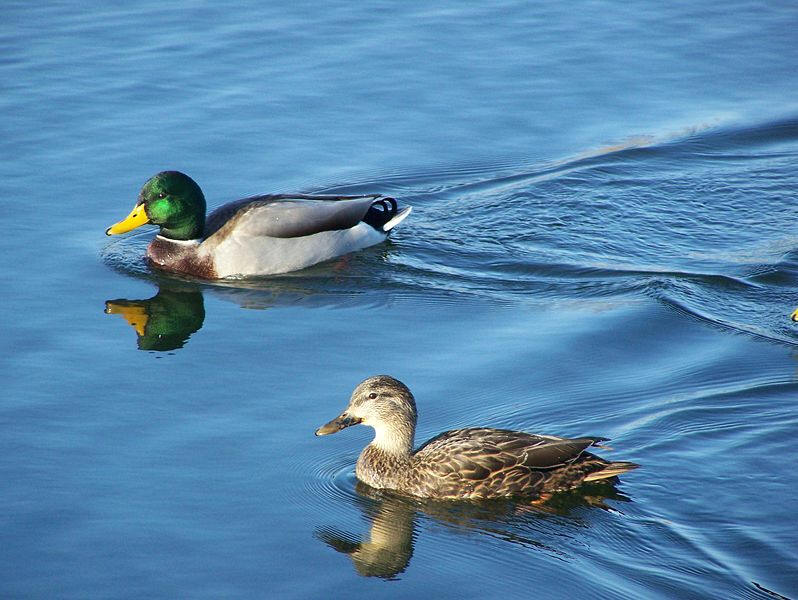
When they are not feeding they swim in the lakes of Old Ranch
The Mallard (Anas platyrhynchos), probably the best-known and most recognizable of all ducks, is a dabbling duck which breeds throughout the temperate and sub-tropical areas of North America, Europe, Asia, New Zealand (where it is currently the most common duck species), and Australia. It is strongly migratory in the northern parts of its breeding range, and winters farther south. For example, in North America it winters south to Mexico, but also regularly strays into Central America and the Caribbean between September and May.

Sue feeds the ducks which are quite tame and enjoy their interaction with the golfers.
Mallards form pairs only until the female lays eggs, at which time she is left by the male. The clutch is 8–13 eggs, which are incubated for 27–28 days to hatching with 50–60 days to fledging. The ducklings are precocial, and can swim and feed themselves on insects as soon as they hatch, although they stay near the female for protection. Young ducklings are not naturally waterproof and rely on the mother to provide waterproofing.

Mommy duck and her eight babies come to say "Hello"
At Old Ranch the Mallards get pesky when they are hungry and often fly onto the 17th and 18th holes to beg for food. We provide crackers and duck food from the local feed store. In spring we can see many babies raised at Old Ranch but the Red Tailed Hawk keep them in check!
Red Tailed Hawk

Red Tailed Hawks fly all around Old Ranch
The Red-tailed Hawk (Buteo jamaicensis) is a medium-sized bird of prey, one of three species colloquially known in the United States as the "chickenhawk." It breeds almost throughout North America from western Alaska and northern Canada to as far south as Panama and the West Indies, and is one of the most common buteos in North America.
There are fourteen recognized subspecies, which vary in appearance and range. It is one of the largest members of the genus Buteo in North America, weighing from 690 to 1600 grams (1.5 to 3.5 pounds) and measuring 45–65 cm (18 to 26 in) in length, with a wingspan from 110 to 145 cm (43 to 57 in). The Red-tailed Hawk displays sexual dimorphism in size, as females are about 25% heavier than males.
The Red-tailed Hawk occupies a wide range of habitats and altitudes, including deserts, grasslands, coniferous and deciduous forests, tropical rainforests, agricultural fields and urban areas. It lives throughout the North American continent, except in areas of unbroken forest or the high arctic. It is legally protected in Canada, Mexico and the U.S. by the Migratory Bird Treaty Act.
Because they are so common and easily trained as capable hunters, the majority of hawks captured for falconry in the United States are Red-tails. Falconers are permitted to take only hawks in their first year.
At Old Ranch they fly overhead watching for potential meals and quite often you can see them taking a recent catch up into their nests high in the trees.
American White Pelican

What a graceful bird
The American White Pelican (Pelecanus erythrorhynchos) is a very large (50"–70") white bird with black wing tips and a long, wide orange bill. They have a wing span of up to 110 inches. Unlike the Brown Pelican, the American White Pelican does not dive for its food. Instead it feeds while swimming. Each bird eats more than 4 pounds of fish a day, mostly carp, chubs, shiners, yellow perch, catfish, and jackfish.
White Pelicans nest in colonies of several hundred pairs on islands in remote brackish and freshwater lakes of inland North America. The most northerly nesting colony can be found on islands in the rapids of the Slave River between Fort Fitzgerald, Alberta and Fort Smith, Northwest Territories. About 10-20% of the population uses Gunnison Island in the Great Basin's Great Salt Lake as a nesting ground. The female lays 2 or 3 eggs in a shallow depression on the ground. Both parents incubate.
They winter in central California and along the Pacific coast of Guatemala; also along the shores of the Gulf of Mexico, its bays and estuaries and along the Mississippi river at least as far north as St. Louis.
They fly into Old Ranch and stay for several months providing great pictures of their graceful flights around the course. We have counted up to 40 individuals often with their offspring sitting at waters edge ;looking for a meal.
This species is protected by the Migratory Bird Treaty Act of 1918. It has the California Department of Fish and Game protective status California Species of Special Concern (CSC).
The scientific name for this species combines Pelecanus, the Latin for pelican, with erythrorhynchos, derived from the Greek words erythros meaning red, and rhynchos meaning beak.
Sparrow

They are pests but nice pests as they chirp the day away
We find them all over the course but mainly around the clubhouse. The House Sparrow (Passer domesticus) is a member of the Old World sparrow family Passeridae, and is, somewhat controversially, considered a relative of the Weaver Finch Family. It occurs naturally in most of Europe and much of Asia. It has also followed humans all over the world and has been intentionally or accidentally introduced to most of the Americas, sub-Saharan Africa, New Zealand and Australia as well as urban areas in other parts of the world. It is now the most widely distributed wild bird on the planet. In the United States it is also colloquially known as the English Sparrow to distinguish it from native species.
Wherever people build, House Sparrows sooner or later come to share their abodes. Though described as tame and semi-domestic, neither is strictly true; humans provide food and home, not companionship. The House Sparrow remains wary of man.They like the snack shack but our members keep the area so clean, they are often disappointed in their foraging activities!
Rabbits

Look carefully as they tend to be near the tall brush ready to run and hide
In spring we see loads of new babies which hide in the tall bushes separating the holes. They come out, watch, and go back in when someone comes near.
Rabbits are ground dwellers that live in environments ranging from desert to tropical forest and wetland. They tend to stay close to the high brush around Old Ranch so they can come out and sun themselves but scurry back into the underbrush when people and golf carts come near! In spring we see the new babies learning form their parents about coming out into the open.
The long ears of rabbits are most likely an adaptation for detecting predators. In addition to their prominent ears, which can measure more than 10 cm (4 in) long, rabbits have long, powerful hind legs and a short tail. Each foot has five digits (one reduced); rabbits move about on the tips of the digits in a fashion known as digitigrade locomotion. Full-bodied and egg-shaped, wild rabbits are rather uniform in body proportions and stance.
The smallest is the pygmy rabbit (Brachylagus idahoensis), at only 20 cm in length and 0.4 kg (0.9 pound) in weight, while the largest grow to 50 cm and more than 2 kg. The fur is generally long and soft, and its color ranges through shades of brown, gray, and buff. Exceptions are the black Amami rabbit (Pentalagus furnessi) of Japan and two black-striped species from Southeast Asia. The tail is usually a small puff of fur, generally brownish but white on top in the cottontails (genus Sylvilagus) of North and South America.
Crow

The crows are often attacked by other birds and the fight is interesting to watch
We have only seen a few crows on the property and they hang out on the back nine where there are a lot of tall trees. Crow (bird), common name for about 27 large passerine birds of the genus which also includes the ravens and jackdaws. Their family also includes the jays, magpies, choughs, and nutcrackers. They are among the most intelligent and adaptable of birds, and several species have been able to thrive near humans, although others, especially on islands, are endangered and their habits little known. Northern-hemisphere crows are sometimes migratory, but often they are resident the year round. Although territorial in the breeding season, crows are gregarious at other times, and wintering flocks may number in the thousands. Even in the breeding season, crows gather together to mob owls and other predators. Crows in turn may be mobbed by other birds, because their omnivorous diet includes eggs and nestlings as well as other small animals, vegetable matter, carrion, and garbage. In some agricultural areas, crows are considered great pests, which accounts for the invention of the scarecrow. Crow nests are large platforms of sticks, usually in tall trees. The three to eight eggs are deeply colored and are incubated by the female. The young are cared for by both parents. The voices of crows are loud and usually harsh, but are characteristic for each species.
All of the North American crows are black, with more or less of a glossy sheen, but several species from elsewhere are conspicuously marked with white or gray. The best known species is the ubiquitous American crow, which has become increasingly adapted to urban areas in the late 20th century. The American crow is up to 50 cm (up to 20 in) long and has an average lifespan of approximately 15 years in the wild.
The Grey Pelican

The love to visit Old Ranch keeping the fish population in control!
The regular diet of a Pelican usually consists of fish, but they also eat amphibians, crustaceans and on some occasions, smaller birds. They often catch fish by expanding the throat pouch. Then they must drain the pouch above the surface before they can swallow. This operation takes up to a minute, during which time other seabirds are particularly likely to steal the fish. Pelicans in their turn sometimes pirate prey from other seabirds.
The white pelicans often fish in groups. They will form a line to chase schools of small fish into shallow water, and then simply scoop them up. Large fish are caught with the bill-tip, then tossed up in the air to be caught and slid into the gullet head first.
The Brown Pelican of North America usually plunge-dives for its prey. Rarely, other species such as the Peruvian Pelican and the Australian Pelican practice this method.
Heron (Great Grey)

Stoic while awaiting their food, they seem to move in slow speed
The herons are wading birds in the Ardeidae family. Some are called egrets or bitterns instead of herons. Within the family, all members of the genera Botaurus and Ixobrychus are referred to as bitterns, and - including the Zigzag Heron or Zigzag Bittern - are a monophyletic group within the Ardeidae. However, egrets are not a biologically distinct group from the herons, and tend to be named differently because they are mainly white and/or have decorative plumes, and while having the same build as the larger herons tend to be smaller.
The classification of the individual heron/egret species is fraught with difficulty, and there is still no clear consensus about the correct placement of many species into either of the two major genera, Ardea and Egretta. Similarly, the relationship of the genera in the family is not completely resolved. However, one species formerly considered to constitute a separate monotypic family Cochlearidae, the Boat-billed Heron, is now regarded as a member of the Ardeidae.
Although herons resemble birds in some other families, such as the storks, ibises and spoonbills, they differ from these in flying with their necks retracted, not outstretched. They are also one of the bird groups that have powder down.
The members of this family are mostly associated with wetlands, and prey on fish, frogs and other aquatic species. Some, like the Cattle Egret and Black-headed Heron, also take large insects, and are less tied to watery environments. Some members of this group nest colonially in trees, others, notably the bitterns, use reedbeds.
They appear to be very stoic animals standing aloof by themselves watching everything that is going on around them and then suddenly taking to the sky or perhaps begin stalking their prey ever so quietly!
Coots
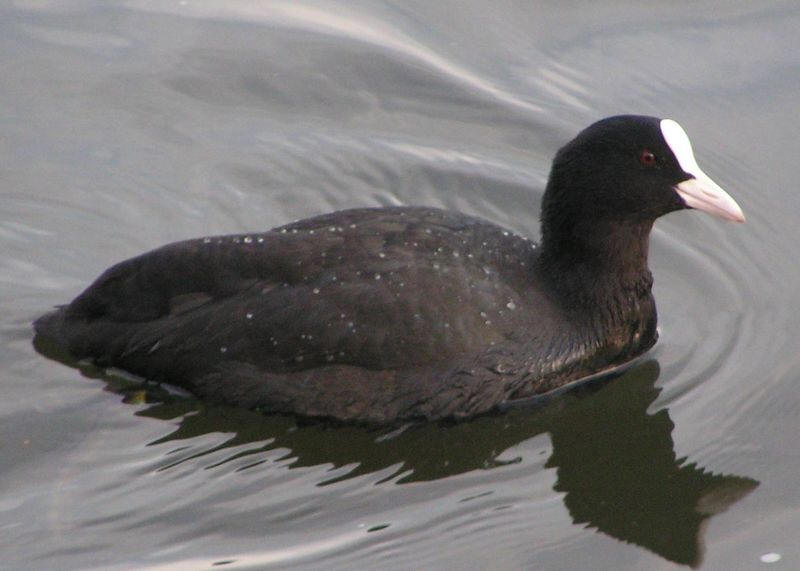
All black except for the forehead, they are strange looking birds
The coots are medium-sized and are members of the rail family. They constitute the genus Fulica.
The greatest species variety is in South America, and it is likely that the genus originated there.
These rails are all predominantly black in plumage, and, unlike many of the rails, they are usually easy to see, often swimming in open water rather than skulking in reedbeds.
They have prominent frontal shields or other decoration on the forehead, and colored bills, and many, but not all, have white on the undertail. Like other rails, they have lobed toes.
They tend to have short, rounded wings and be weak fliers, although northern species are nevertheless capable of covering long distances; the American Coot has reached Great Britain and Ireland on rare occasions. Those species that migrate do so at night.
Coots can walk and run vigorously on strong legs, and have long toes that are well adapted to soft, uneven surfaces.
These birds are omnivorous, taking mainly plant material, but also small animals and eggs. They are aggressively territorial during the breeding season, but are otherwise often found in sizeable flocks on the shallow vegetated lakes they prefer. A flock of coots is known in the US as a cover.
While they are interesting they are messy preferring to poop right on the grass and many times where the golf balls end up! We often "chase" them... more like harass them... to go into the water and leave the area surrounding the greens for obvious reasons.
Seagulls

Seagulls have a short distance to fly to get to Old Ranch
Gulls (often informally Seagulls) are birds in the family Laridae. They are most closely related to the terns (family Sternidae) and only distantly related to auks, and skimmers, and more distantly to the waders. Most gulls belong to the large genus Larus.
They are typically medium to large birds, usually grey or white, often with black markings on the head or wings. They have stout, longish bills, and webbed feet. Gull species range in size from the Little Gull, at 120 g (4.2 oz) and 29 cm (11.5 inches), to the Great Black-backed Gull, at 1.75 kg (3.8 lbs) and 76 cm (30 inches).
Most gulls, particularly Larus species, are ground nesting carnivores, which will take live food or scavenge opportunistically. The live food often includes crabs and small fish. Apart from the kittiwakes, gulls are typically coastal or inland species, rarely venturing far out to sea. The large species take up to four years to attain full adult plumage, but two years is typical for small gulls.
Gulls — the larger species in particular — are resourceful and highly-intelligent birds, demonstrating complex methods of communication and a highly-developed social structure; for example, many gull colonies display mobbing behavior, attacking and harassing would-be predators and other intruders.
They abound year around as we are so close to the ocean. They are not pesky and prefer to be within their own group.
Mourning Doves
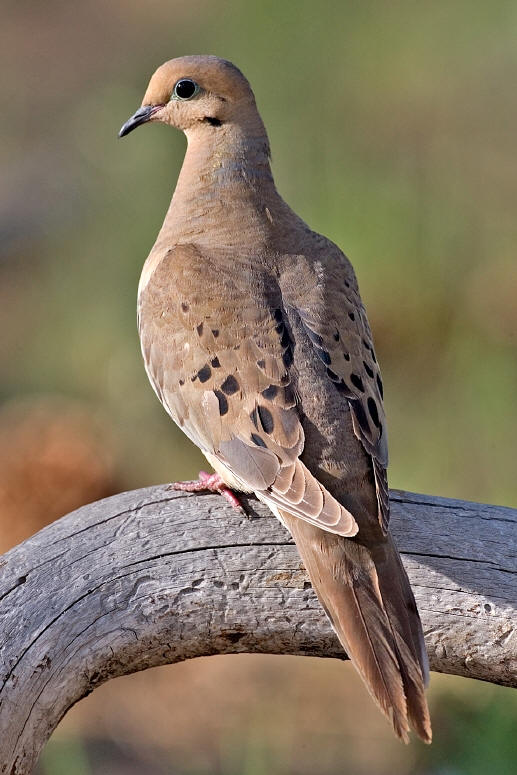
They make noises as they fly that are very distinctive
The Mourning Dove (Zenaida macroura) is a member of the dove family Columbidae. The bird is also called the American Mourning Dove, and formerly was known as the Carolina Pigeon or Carolina Turtledove. It ranges from Central America to southern Canada, including offshore islands. Many individuals in northern areas migrate south to spend winter within the breeding range where January temperatures are above −12° Celsius (10°F).
Habitats include various open and semi-open environments, including agricultural and urban areas. The species has adapted well to areas altered by humans. The bird is abundant, with an estimated population of 130 million birds. In many areas, the Mourning Dove is hunted as a game bird for both sport and its meat. Its plaintive woo-oo-oo-oo call is common throughout its range, as is the whistling of its wings as it takes flight. The species is a strong flier, capable of speeds up to 88 km/h (55 mph).
Mourning Doves are light grey and brown and generally muted in color. Males and females are similar in appearance. The species is generally monogamous, with two squabs (young) per brood. Both parents care for the young for a time. The species is a prolific breeder, and pairs will often have several broods per year. In warm areas, one pair may have up to six broods a year. Mourning Doves eat mainly seeds, including those of both native and introduced plants.
Because of their color one has to look carefully but in spring and summer you can see them all over the grounds of Old Ranch specially at the edge of the grassy areas walking in the mulched areas blending into the mulch amazingly well!
Curlew
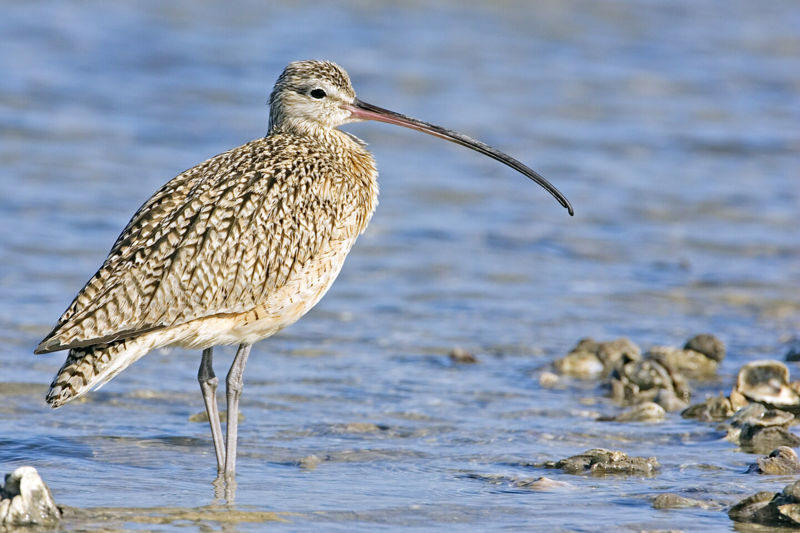
They are found at waters edge looking for delightful morsels of foodies
Curlew is the common name for the bird genus Numenius, a group of eight wader species, characterized by a long slender downcurved bill and mainly brown plumage with little seasonal change. They are one of the most ancient lineages of scolopacid waders, together with the godwits which look similar but have straight bills. In Europe "Curlew" usually refers to one species, the Eurasian Curlew Numenius arquata.
Curlews feed on mud or very soft ground, searching for worms and other invertebrates with their long bills. They will also take crabs and similar items. When it rains or just after the grounds are watered these little guys have a field day at Old Ranch.
Coyote

Often seen at dusk, they come from the surrounding fields and live in the storm drains
The coyote (Canis latrans), also known as the prairie wolf, is a mammal of the order Carnivora. The species is found throughout North and Central America, ranging from Panama in the south, north through Mexico, the United States, and Canada. It occurs as far north as Alaska and all but the northernmost portions of Canada. You will often see these guys late in the evening and at night wondering the grounds. They likely live in the storm drains which are adjacent to the Old Ranch Property. In the Seal Beach area there are often warning signs in the local neighborhoods about keeping your small pets indoors and under watch because of the coyotes which enter the local areas. At Old Ranch we watch the sand bunkers for indications of their presence as their tracks are easy to spot.
The Great Egret

The tend to lurk around waters edge looking for their next meal
The Snowy Whites are very pretty against the green backdrop of Old Ranch.
The Great Egret Ardea alba, also known as the Great White Egret, White Heron, or Common Egret, is a wading egret, found in most of the tropical and warmer temperate parts of the world, although it is very local in southern Europe and Asia. It is called Kōtuku in New Zealand. It is sometimes confused with the Great White Heron in Florida, which is a white morph of the Great Blue Heron.
The Great Egret is a large bird with all white plumage that can reach 101 cm in height and weigh up to 950 g. It is only slightly smaller than the Great Blue or Grey Herons. Apart from size, the Great Egret can be distinguished from other white egrets by its yellow bill and black legs and feet. It also has a slow flight, with its neck retracted. This is characteristic of herons and bitterns, and distinguishes them from storks, cranes and spoonbills, which extend their necks.
Tern
We have no quite figured out which one we have but we have a load of them.
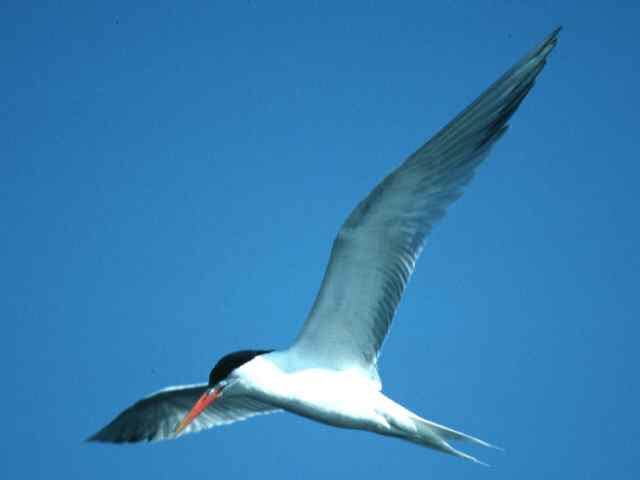
Quick birds that can turn on a dime!
The Arctic Tern (Sterna paradisaea) is a seabird of the tern family Sternidae. This bird has a circumpolar distribution, breeding colonially in Arctic and sub-Arctic regions of Europe, Asia, and North America (as far south as Brittany and Massachusetts). The species is strongly migratory, seeing two summers each year as it migrates from its northern breeding grounds to the oceans around Antarctica and back (about 24,000 miles) each year. This is the longest regular migration by any known animal.
Arctic Terns are medium-sized birds. They have a length of 33–39 centimetres (13–15 in) and a wingspan of 76–85 cm (26–30 in). They are mainly grey and white plumaged, with a red beak (as long as the head, straight, with pronounced gonys) and feet, white forehead, a black nape and crown (streaked white), and white cheeks. The grey mantle is 305 mm, and the scapulars are fringed brown, some tipped white. The upper wing is grey with a white leading edge, and the collar is completely white, as is the rump. The deeply forked tail is whitish, with grey outer webs. The hindcrown to the ear-coverts is black.
Arctic Terns are long-lived birds, with many reaching twenty years of age. They eat mainly fish and small marine invertebrates. The species is abundant, with an estimated one million individuals. While the trend in the number of individuals in the species as a whole is not known, exploitation in the past has reduced this bird's numbers in the southern reaches of its range.
Cat Fish

Ever walk by the edge of a lake and hear a large splash? You just scared one of the large Old Ranch Cat Fish!
We have only seen these guys after some of the staff went fishing one afternoon. The guys were catching them pretty easily on the 10th hole. We did not have a camera with us but they were the typical channel catfish.
Catfish (order Siluriformes) are a very diverse group of cartilaginous fish. Named for their prominent barbels, which give the image of cat-like whiskers, catfish range in size and behavior from the heaviest, the Mekong giant catfish in Southeast Asia and the longest, the wels catfish of Eurasia, to detritivores (species that eat dead material on the bottom), and even to a tiny parasitic species commonly called the candiru, Vandellia cirrhosa. There are armour-plated types and also naked types, neither having scales. Despite their common name, not all catfish have prominent barbels; what defines a fish as being in the order Siluriformes are in fact certain features of the skull and swimbladder. Catfish are of considerable commercial importance; many of the larger species are farmed or fished for food, and some are exploited for sport fishing, including a kind known as noodling. Many of the smaller species, particularly the genus Corydoras, are important in the aquarium hobby.
Alligators (Not Really... We Hope)

Oops! Maybe I will not play this ball!
Just fooling! I think!
Upon A Time There Was A Mad Duck!
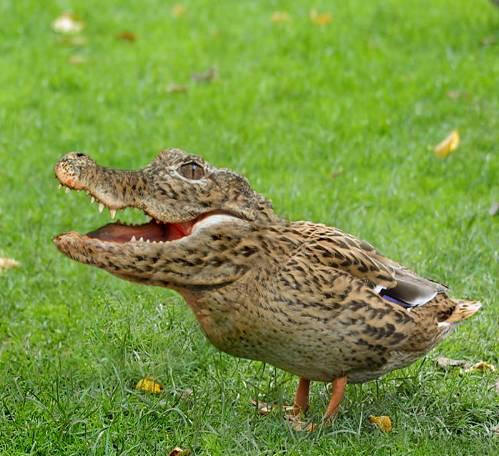
An Old Ranch Duck-a-gator spotted on the 10th hole
OK, lets start out slow! On this day in July there were ducks... ferocious ducks with huge teeth in their bills!
Minding our own business we were accosted for crackers by a herd of ducks at the 10th hole! After the feeding, they proceeded to put on a small wrestling match for us.
Ducks charging each other, calling each other names (we think that was the case as none of us speak fluent duck), and biting and pulling out each others feathers.
After a bite, they ducks would be coughing up feathers just like in the cartoons! Feathers everywhere! Where was the movie camera when we needed it? It was horrible (horribly funny).
Before we were allowed to leave and proceed with the game, we had to be frisked by the ducks to make sure the players were not hoarding crackers or other food the ducks liked! Ever been frisked by a duck?
Visit The Flowers Of Old Ranch

